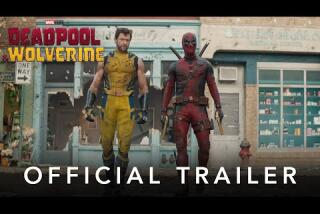Tough-as-nails filmmaker
It seems appropriate that the UCLA Film & Television Archive has called its retrospective on the Oscar-winning writer-director of such film classics as 1955’s “Blackboard Jungle,” 1960’s “Elmer Gantry” and 1967’s “In Cold Blood” “Looking for Richard Brooks: An Appreciation.”
The title is a play on his last hit, 1977’s “Looking for Mr. Goodbar,” but it sums up Brooks’ reputation in the 19 years since his death. Whereas other writer-directors such as Billy Wilder and John Huston have grown in stature since their demise, Brooks’ legacy has been put on the back burner. But that may change with this retrospective, which begins Friday at the Billy Wilder Theater, and the recently published book, “Tough as Nails: The Life and Films of Richard Brooks” by Douglass K. Daniel.
Scott Wilson, who played murderer Dick Hickock in Brooks’ adaptation of Truman Capote’s “In Cold Blood,” said it’s time people take notice of the filmmaker. “I feel despite the number of Academy Awards that his films received, he is one of the more underrated directors,” said the actor, who will be appearing Friday at the screening of his film.
Daniel believes Brooks’ reputation has suffered because “he was a bit of a loner. He wasn’t interested in becoming better known than the movies themselves.”
He also was hard to peg as a filmmaker; he did thrillers, romantic dramas, epics and westerns. “He was never considered an auteurist,” said UCLA archive head Jan-Christopher Horak. “He doesn’t fit into this auteurist mold of a consistent theme. Other writer-directors would choose topics that somehow always jelled with their personality. He seems more to disappear behind those adaptations.”
Brooks was born to Russian Jewish immigrants in Philadelphia. Graduating from Temple University, he worked as a sports reporter for several newspapers, was a staff writer at NBC Radio in New York during the 1930s and began directing at the Mill Pond Theatre in New York. He came to Hollywood and was a staff writer on low-budget films, including the 1943 Maria Montez-Jon Hall romantic fantasy “White Savage,” screening April 16.
Serving in the Marines during World War II, he managed to write novels, making a big splash in 1945 with “The Brick Foxhole,” about a group of Marines who pick up and murder a gay man. The 1947 film version, “Crossfire,” screening Saturday, had to change the gay victim to a Jewish man because of censorship issues.
After the war, he returned to writing scripts, including for John Huston’s 1948 film noir “Key Largo,” screening April 16, with Humphrey Bogart and Lauren Bacall; and the 1947 prison flick “Brute Force,” also screening April 16, with Burt Lancaster. In 1950, Brooks wrote and directed his first film, the thriller “Crisis,” screening Sunday, with Cary Grant. He hit his stride with “Blackboard Jungle,” also April 16, which looks at troubled youth in a New York school and features the first rock theme song, “Rock Around the Clock” by Bill Haley and His Comets.
He earned his first of eight Oscar nominations for this screenplay. The movie bolstered the career of star Glenn Ford as well as the actors playing the students, including Sidney Poitier, Paul Mazursky and Vic Morrow.
He directed Lancaster and Shirley Jones to Oscars, also winning one for himself for his adapted screenplay for “Elmer Gantry,” screening April 23. Among his other Oscar-nominated work are 1958’s “Cat on a Hot Tin Roof” with Paul Newman and Elizabeth Taylor, based on the Tennessee Williams play, screening April 10; the 1966 western “The Professionals,” screening May 25; and “In Cold Blood.”
There is a good reason Daniel’s book is called “Tough as Nails,” because Brooks was just that on the set. “If you saw him on the set at times, he was a pit bull in action, but he could also charm the birds out of the trees,” said Wilson, who admitted he had a love-hate relationship with Brooks. “He was very forthright and spoke what was on his mind. If you had an issue with him about something, he would say, ‘You do that in your movie. This is my movie.’ ”
Brooks also would never give his cast the full script. “If a scene was coming up that he felt you needed to work on more, he would give it to you two or three days ahead of time,” said Wilson. “But once the scene was shot, he would take the pages back from you.”
“In Cold Blood” was Brooks’ last great film. Two years later, he directed his then wife, Jean Simmons, whom he met on “Elmer Gantry,” to a lead actress Oscar nod in the 1969 drama “The Happy Ending,” screening May 1. He made three films in the 1970s, the last being “Looking for Mr. Goodbar,” screening May 22, a disturbing adaptation of Judith Rossner’s bestseller starring Diane Keaton as a bar-hopping sex-addicted teacher.
His final two films -- 1982’s “Wrong Is Write” and 1985’s “Fever Pitch” -- were poorly received. He died of congestive heart failure at age 79 in 1992.
Wilson said Brooks was a filmmaker who demanded respect. “He was dedicated to making the film everything he wanted it to be. It was inspiring to be around him, and it’s still inspiring.”
--
--
‘Looking for Richard Brooks: An Appreciation’
Where: UCLA Film & Television Archive’s Billy Wilder Theater, 10899 Wilshire Blvd.
When: Friday through
May 25
Price: $9 for general admission; $8 for students and seniors
Contact: (310) 206-8012 or visit www.cinema.ucla.edu
More to Read
Only good movies
Get the Indie Focus newsletter, Mark Olsen's weekly guide to the world of cinema.
You may occasionally receive promotional content from the Los Angeles Times.







